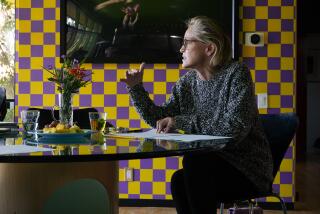Commentary: Why ‘The L Word’ was must-see lesbian TV — and the reboot doesn’t need to be
In 2004, “The L Word” introduced television audiences to a group of close-knit queer women and their vibrant, messy, melodramatic slice of West Hollywood life. For many of us, it was love at first sight.
The first series focused primarily on the stories of lesbian and bisexual women. “The L Word” flaunted its sharp and sexy characters, including the unapologetically queer, unhappily closeted and uncertain about their identity. The show was far from perfect but fans relished the grains of truth in the glossy, over-the-top fantasy.
Showtime’s “The L Word” was criticized for its depiction of transgender man Max. Now, with GLAAD’s help, sequel “Generation Q” hopes to do better.
Showtime is looking to revive that magic with the sequel series “The L Word: Generation Q,” which premieres Sunday. Showrunner Marja-Lewis Ryan has brought back three of the original leads (Jennifer Beals, Leisha Hailey and Katherine Moennig), whose lives now intersect with a new generation of characters. But the current TV landscape is much changed in the 10 years since the original series came to an end in 2009.
“The L Word” arrived at a time where queer women were very much starved for any sort of consistent, positive representation in mainstream media. The tides were slowly turning but, prior to the 2000s, TV story lines involving queer women were often relegated to sweeps week stunts — in the form of one-off kisses — and secondary to those of their straight counterparts.
“Buffy the Vampire Slayer,” “ER” and “The Wire” were among the shows in the early 2000s that helped change TV by featuring lesbian characters in their main cast. But none is comparable to “The L Word,” which was the only series devoted to showing how queer women long, lust, love and live.
“It would be lovely if [‘The L Word’] had some positive effect, but I don’t feel any kind of social or political responsibility. My responsibility is to tell good stories,” the show’s creator and executive producer Ilene Chaiken told the Times in advance of its 2004 premiere.
But telling “good stories” about queer women was in itself a political act: It’s through such stories that people’s perception and understanding can evolve, especially if they don’t often interact with LGBTQ people in real life. That’s to say nothing of the impact the show had on many in its queer audience. Seeing stories reflective of our experiences and identities affects how we see ourselves.
“The L Word” attracted a faithful following for tackling issues that weren’t addressed anywhere else on TV: interracial lesbian relationships, the professional risks of being out, an immediate social circle that includes past lovers, artificial insemination and more.
And if it was limited by the demographics of its majority-white, middle-class ensemble and its aforementioned missteps — the stereotypical portrayals of transgender characters, casual biphobia and habit of featuring non-Latina actresses as prominent Latina characters — the show nonetheless managed to be sexy and serious, outlandish and topical at the same time.
“The L Word” gave fans like me a chance to see queer women in situations beyond coming-out stories. These were women in committed relationships, women having flings, women trying to figure out if their crushes were gay or straight and women who joked about lesbian stereotypes while engaging in said stereotypical behavior.
Love it or love-to-hate it, watching the show felt like a communal experience, whether you were hosting viewing parties or found yourself participating in impromptu group discussions. The show gave us archetypal characters that people still reference today.
Although there’s been no true heir apparent to “The L Word,” GLAAD’s most recent “Where We Are on TV” report found that LGBTQ representation on TV is at a record high for the 2019-20 season. According to the report, LGBTQ characters made up 10.2% of all series regulars in prime-time scripted shows on broadcast networks. More than half of the regular and recurring LGBTQ characters in broadcast prime-time scripted shows are queer women.
Compared to when the original “L Word” was airing, there are many more LGBTQ characters on all kinds of different TV shows.
And it’s not just about quantity, either. Nowadays, there is nuanced storytelling about queer women happening in legal dramas (“How to Get Away With Murder”), superhero shows (“Batwoman” and the rest of the Arrowverse), teen mysteries (“Riverdale”), historical dramas (“Gentleman Jack”), supernatural shows (“Wynonna Earp”), spy thrillers (“Killing Eve”) and more.
There are also shows like “Pose” and “Vida” that center the stories of queer and trans people of color, as well as inclusive cartoons like “Steven Universe” and “She-Ra and the Princesses of Power” making sure LGBTQ kids feel seen.
Nonbinary shapeshifter Double Trouble fits perfectly into the inclusive world of Netflix’s “She-Ra and the Princesses of Power.”
In a way, this means “Generation Q” can be held to a higher standard than its predecessor, because there are so many alternatives. It also means the show doesn’t have to shoulder the undue burden of trying to represent all queer women, because it isn’t alone.
This time, the cast is more inclusive and the politics are a bit more overt: “Generation Q” is a series aware of its history, in terms of both the original’s legacy and how much things have changed for the LGBTQ community since it wrapped in 2009. (The cast and crew have been candid about how the new show aims to correct some of the original show’s mistakes.) After all, it’s more than the television landscape that’s undergone a profound transformation. “Don’t ask, don’t tell” has been repealed. Marriage equality has been recognized as a constitutional right. California is among the states that recognize nonbinary gender on state-issued ID cards and driver’s licenses.
On the other hand, the Trump administration has been actively chipping away at the rights and protections of the LGBTQ community, and studies show an increasing number of young people reporting being less comfortable around LGBTQ people.
In a more fragmented world for both politics and television, it’s unlikely that the sequel’s broader representation, or nostalgia for the original, will catapult “Generation Q” to the same cultural status as its predecessor — but it may not need to. Young people have had access to more positive images of fictional and real queer women than their counterparts of 15 years ago.
“The L Word” already accomplished so much. Watching “Generation Q” just because we want to is a luxury worth celebrating.
More to Read
The complete guide to home viewing
Get Screen Gab for everything about the TV shows and streaming movies everyone’s talking about.
You may occasionally receive promotional content from the Los Angeles Times.







